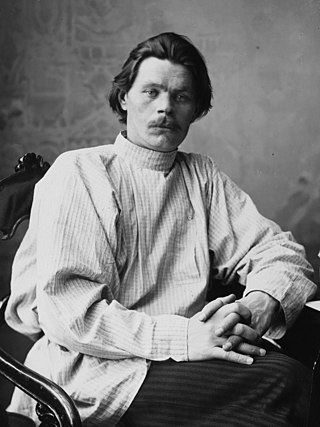
Alexei Maximovich Peshkov, popularly known as Maxim Gorky, was a Russian and Soviet writer and socialist political thinker and proponent. He was nominated five times for the Nobel Prize in Literature. Before his success as an author, he travelled widely across the Russian Empire changing jobs frequently, experiences which would later influence his writing.

Novosibirsk Oblast is a federal subject of Russia located in southwestern Siberia. Its administrative and economic center is the city of Novosibirsk. As of the 2021 Census, Novosibirsk Oblast had a population of 2,797,176.
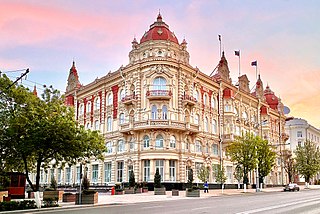
Rostov-on-Don is a port city and the administrative centre of Rostov Oblast and the Southern Federal District of Russia. It lies in the southeastern part of the East European Plain on the Don River, 32 kilometers (20 mi) from the Sea of Azov, directly north of the North Caucasus. The southwestern suburbs of the city lie above the Don river delta. Rostov-on-Don has a population of over one million people and is an important cultural center of Southern Russia.

Kolomna is a historical city in Moscow Oblast, Russia, situated at the confluence of the Moskva and Oka Rivers, 114 kilometers (71 mi) southeast of Moscow. Population: 144,589 (2010 Census); 150,129 (2002 Census); 161,881 (1989 Census).

The Russian apartment bombings were a series of explosions that hit four apartment blocks in the Russian cities of Buynaksk, Moscow, and Volgodonsk in September 1999, killing more than 300, injuring more than 1,000, and spreading a wave of fear across the country. The bombings, together with the Invasion of Dagestan, triggered the Second Chechen War. The handling of the crisis by Vladimir Putin, who was prime minister at the time, boosted his popularity greatly and helped him attain the presidency within a few months.

Nizhny Novgorod Oblast is a federal subject of Russia. Its administrative center is the city of Nizhny Novgorod. It has a population of 3,119,115 as of the 2021 Census. From 1932 to 1990 it was known as Gorky Oblast.

Lipetsk Oblast is a federal subject of Russia. Its administrative center is the city of Lipetsk. As of the 2021 Census, its population was 1,143,224.

Tula Oblast is a federal subject of Russia. It is geographically located in European Russia and is administratively part of the Central Federal District, covering an area of 25,700 square kilometers (9,900 sq mi). It has a population of 1,553,925 (2010 Census). Tula is the largest city and the administrative center of the oblast.
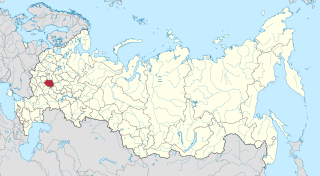
Ryazan Oblast is a federal subject of Russia. Its administrative center is the city of Ryazan, which is also the oblast's largest city.

Ryazan is the largest city and administrative center of Ryazan Oblast, Russia. The city is located on the banks of the Oka River in Central Russia, 196 km (122 mi) southeast of Moscow. As of the 2010 Census, Ryazan had a population of 524,927, making it the 33rd most populated city in Russia, and the fourth most populated in Central Russia after Moscow, Voronezh, and Yaroslavl.

Gevorkyan v. Moshkov was a landmark case that established the precedent for the application of Russian copyright law to online services.
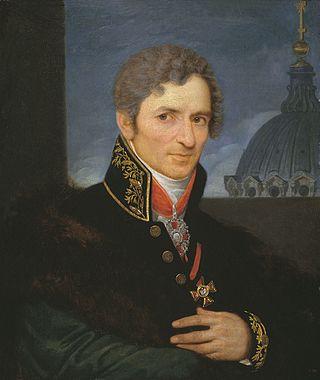
Andrey (Andrei) Nikiforovich Voronikhin was a Russian architect and painter. As a representative of classicism he was also one of the founders of the monumental Russian Empire style. Born a serf of the Stroganov family, he is best known for his work on Kazan Cathedral in Saint Petersburg.

The Moscow Orphanage or Foundling Home was an ambitious project conceived by Catherine the Great and Ivan Betskoy, in the early 1760s. This idealistic experiment of the Age of Enlightenment was intended to manufacture "ideal citizens" for the Russian state by bringing up thousands of abandoned children to a very high standard of refinement, cultivation, and professional qualifications. Despite more than adequate staffing and financing, the Orphanage was plagued by high infant mortality and ultimately failed as a social institution.
The Tale of the Destruction of Ryazan (by Batu) (Russian: Повесть о разорении Рязани Батыем, romanized: Povest' o razorenii Riazami Batyem) is a Russian literary work about the capture of the city of Ryazan by the Mongols in 1237. It is compiled from earlier manuscripts.

Alabuga is a special economic zone of an industrial and production type located in a 20 km² area in the Yelabuzhsky District of the Republic of Tatarstan in the Kama Innovative Territorial Production Cluster 10 km from Yelabuga, 25 km from Naberezhnye Chelny, 40 km from Nizhnekamsk and 210 km from the regional center — Kazan. The shareholders of the management company of the SEZ "Alabuga" are the Russian Federation through the JSC "Special Economic Zones" with 100% state participation (66%) and the Ministry of Land and Property of the Republic of Tatarstan (34%).
SU-155 Group is a Russian vertically integrated group of companies which is a leader in the Russian building construction industry. Besides building construction and real estate development, the group conducts activities in construction and non-metallic materials manufacturing, mechanical engineering, and investing in land, engineering and public infrastructure. The group headquarters is in Moscow.
Igor Alexandrovich Putin is a Russian businessman and politician, former vice president of Master Bank. He is a first cousin of the Russian President, Vladimir Putin. He is the Chairman of Igor Putin Fund, an investment company supporting and developing the industry in outlying regions of Russia.

Skopinsky District is an administrative and municipal district (raion), one of the twenty-five in Ryazan Oblast, Russia. It is located in the southwest of the oblast. The area of the district is 1,720 square kilometers (660 sq mi). Its administrative center is the town of Skopin. Population: 27,080 ; 31,142 (2002 Census); 40,965 (1989 Census).
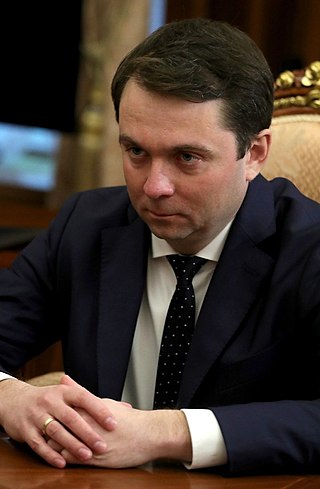
Andrey Vladimirovich Chibis, is a Russian statesman and politician. He is currently the 5th Governor of Murmansk Oblast, since 27 September 2019. He was the acting governor of Murmansk Oblast in 21 March 2019 before officially sworn into office. He is the Secretary of the Murmansk regional branch of the United Russia party since 15 November 2019.

Anton Kandinov was an architect who worked in Baku in 1881-1891 and was responsible for the Islamiyya caravanserai, the Winter club, as well as more than other 40 buildings.




















